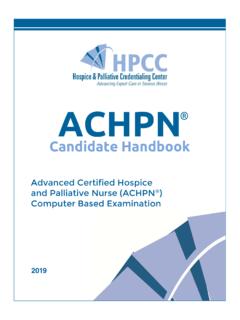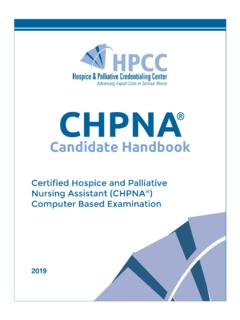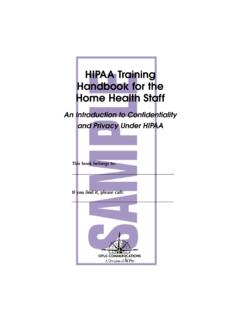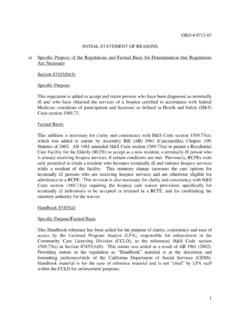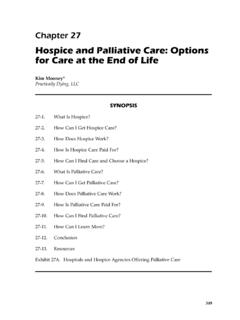Transcription of The Family Handbook of Hospice Care
1 The Family Handbook of Hospice CareFairview Hospice Fairview Health ServicesFairview Press MinneapolisTHE Family Handbook OF Hospice care 1999 Fairview Hospice , Fairview Health Services. All rights reserved. Except as noted on certain forms throughout this book, no part of this publication may be used or reproduced in any manner whatsoever without written permission, except in the case of brief quotations embod-ied in critical articles and reviews. Forms may be reproduced for personal use only. For further information, please contact the by Fairview Press, 2450 Riverside Avenue, Minneapolis, MN 55454. Fairview Press is a division of Fairview Health Services, a community-focused health system, affiliated with the University of Minnesota, providing a complete range of services, from the prevention of illness and injury to care for the most complex medical conditions. For a free current catalog of Fairview Press titles, call toll-free 1-800-544-8207, or visit our Web site at Printing: October 1999; Revised January 2008 Printed in the United States of AmericaWriter: K ren Hess, Innovative Programming Systems Disclaimer:This publication is designed to provide accurate and authoritative information in regard to the subject matter cov-ered.
2 It is sold with the understanding that the publisher is not engaged in the provision or practice of medical, nursing, or professional healthcare advice or services in any jurisdiction. If medical advice or other ?professional assistance is required, the services of a qualified and competent professional should be sought. Fairview Press is not responsible or liable, directly or indirectly, for any form of damages whatsoever resulting from the use (or misuse) of information contained in or implied by these 520037 REV 03/12 Did you know that Fairview Hospice , a non-profit organization, relies on donations to support the care we provide? Many of our services not covered by Medicare or private insurance. Your generous donations allow us to offer music and massage therapy, medication delivery, grief support, and more. To donate to Fairview Hospice , call us at 612-721-2491 or toll-free at 1-800-285-5647. Or write to us at Fairview Hospice , 2450 26th Avenue South, Minneapolis, MN 55406.
3 Or go to to donate online. Thank you for your things may change us, but we start and end with Family . Anthony BrandtWith deep gratitude, we dedicate this book to the patients and families whom we have been privileged to know and serve over the years. You have inspired us. May the blessings you have given others through your love and service come back to and caregivers have often asked Fairview Hospice for written information to help them care for their terminally ill loved ones at home. The Family Handbook of Hospice care has been a dream of Fairview Hospice staff for many years. This dream became a reality when Fairview Press recognized the value of the project and offered to assist us. We wish to thank the following people whose contributions were particularly helpful in the preparation of this Hospice patients and families inspire us daily to learn new and better ways of supporting them as they journey together into an uncertain future.
4 We would especially like to thank Katherine Baumgartner, whose beloved father, Olaf Kaasa, was a patient of Fairview Hospice . Her perspective as a Family caregiver was extremely valuable in creating this book. Our Fairview Hospice staff, who conceived the very idea for this book, gave unselfishly of their time to convey the essence of our message to the writer. We would especially like to thank the core committee members for their many hours discussing and editing the text under tight deadlines. These individuals include Kathleen Lucas, Virginia Bender, Tami Schoenbauer, Steve Sims, Jean Campbell, and Mary Hagen. Our writer, K ren Hess, listened intently, revised repeatedly without ego, and captured the essence of the message beautifully. Her openness, willingness to learn, and easygoing style made this book Family Handbook of Hospice care would continue to be a loose collection of miscellaneous booklets and photocopied handouts if Marne Oberg and Lyndsay Hall of Fairview Public Relations had not recognized its potential and called Fairview Press to explore the feasibility of writing a generous contributions of two other individuals have helped turn this book into an excellent resource for patients and families.
5 Larry Beresford, a former senior writer for the National Hospice and Palliative care Organization, took time out from his very busy schedule to write a thought-provoking foreward, and Kristin Dungan of Fairview s legal department was kind enough to act as a consultant for the legal the staff at Fairview Press, a very special thank you for providing the talent and expertise necessary to deliver a wonderful resource for Hospice families and staff everywhere. Lane Stiles understood our dream and saw the possibilities. Stephanie Billecke, our editor, also deserves enormous gratitude. She was our shepherd and coach, possessed of a great sense of commitment, dedication, humor, and patience. Without Stephanie, we would still be ixYou re Not Alone: How Hospice Can Help 1:1 What is Hospice ? 1:2 The Cornerstone of Hospice 1:3 Who Might Benefit from Hospice ? 1:5 Making the Decision 1: 5 The Role of the Patient 1:6 The Role of the Family 1:6 The Role of Hospice 1: 7 The care Plan 1:8 Tears and Smiles: Coping with a Terminal Illness 2:1 The Stages of Dying In Theory 2:2 The Reality of Dying 2:5 Relationships 2:9 Spiritual Issues 2:10 Being a Caregiver: One Day at a Time 3:1 Facing Change 3:2 Tending to Physical Needs 3:4 Making Decisions 3:4 The Emotional Roller Coaster 3:5 Spiritual Support 3:6 Communication 3:6 Maintaining Quality of Life 3:7 Tending to Children s Needs 3:7 Maintaining Balance 3:8 Caregiving as a Partnership 3:9 Daily Caregiving: Each Day a Gift 4:1 Setting Up the Home 4:2 Equipment and Supplies 4:4 Getting Organized 4:5 Coming Home 4:6 Daily Physical care 4:6 Caring for Symptoms 4:9 Activities to Fill the Day with Joy 4:13 Exercise 4:14 Maintaining Sexuality 4:15 Reducing Stress 4.
6 15 Pain: Control Is the Goal 5:1 Understanding Pain 5:2 Pain Assessment 5:4 The Pain Management Plan 5:4 Complementary Therapies: Creating Wholeness and Meaning 6:1 Holistic care 6:2 Music Therapy 6:3 ContentsMassage Therapy 6:5 Holistic care at the End of Life 6:7 Nutrition: Nourishment Is More Than Food and Drink 7:1 Loss of Appetite 7:2 Making Mealtimes Enjoyable 7:3 Fluid Needs 7:4 Common Causes of Eating Problems 7:4 Artificial Hydration and Nutrition 7:8 When Eating and Drinking Stop 7:9 Financial and Legal Preparations: Getting One s House in Order 8:1 Paying for Hospice care 8:2 Lifetime Planning 8:5 Financial Arrangements 8:5 Healthcare Decisions 8:7 Planning the Funeral or Memorial 8:9 Other Final Preparations 8:11 Document Checklist 8:12 When Death Is Near: Your Final Days Together 9:1 care Options 9:2 Involving Children 9:3 When Your Loved One Wants to Hasten Death 9:4 Remaining Close until the End 9:4 Signs That Death Is Approaching 9:6 When Death Is Very Near 9:9 The Moment of Death 9:9 Immediately after Death 9:10 The End of a Journey 9:10 After the Loss: Moving On 10:1 Grief 10:2 Hospice Bereavement Support 10:5 Getting Past the Pain 10:6 Bereaved Children 10:7 Practical Matters 10:8 Moving On 10:12 Resources: Where to Find Information and Help 11:1 Books and Pamphlets 11:1 Organizations and agencies 11:5 ixThe basic message of this book and of the Hospice approach of compassionate care for the dying is twofold: Caregiving may be the hardest thing you will ever do, the authors state.
7 Even so, most people who have done it say the challenge is worthwhile. For three decades, highly motivated Hospice professionals and volunteers throughout this country have striven mightily to make the final chapter of life less painful, less difficult, more manageable, and, at its best, more meaningful for both patients and their families. Yet too often Hospice is dimly understood, misunderstood, feared, or avoided. When Hospice enters your life, in all likelihood it means your loved one is seriously ill and likely will not survive his or her illness. Despite people s instinctive fears, Hospice won t make a loved one s death come any sooner or with greater certainty. Hospice is all about making the very best of this frightening situation, helping you to play the hand you have been dealt so that years later you will feel you did the right thing for your loved one. But before you can allow Hospice s support into your life, you must begin to confront the painful reality of an impending the spring of 1999, public opinion research conducted for the National Hospice Foundation of Arlington, Virginia, showed that while Americans have a vague notion of what Hospice care is, few understand how it works or that Medicare pays for it.
8 Few are aware that Hospice provides emotional support and pain relief, and only 13 percent say they would call their local Hospice if a Family member or close friend were confronting a terminal , in recent years, deeply held fears about how Americans expect to be treated by the conventional healthcare system at the end of life have been widely documented. The 1997 focus group study, The Quest to Die with Dignity, issued by a national coalition of citizen health advocacy groups called American Health Decisions, concluded that Americans of all ages and races fear a medically intrusive, mechanical pathway to death. Yet they avoid doing the one thing that could make the greatest difference discussing their fears and wishes with their Family or doctor. In fact, the National Hospice Foundation discovered that Americans are more willing to talk about safe sex or drug abuse with their children than to discuss end-of-life care with an aging from coast to coast report that many patients are referred to Hospice care very late in their illness often days or even hours before death.
9 That makes it difficult for Hospice to offer much more than short-term crisis management, though a peaceful, comfortable, self-determined final chapter might have been possible. A comfortable end may afford priceless opportunities to say meaningful farewells, to heal long-standing emotional rifts, and to find an element of closure in and over, Family survivors say, If only we d known about Hospice sooner. Perhaps for some Family caregivers, this book will forestall that complaint. Hospice can t change the sad ending of these all-too-common human dramas, but it may be able to make them more tolerable. Ultimately, however, as the authors note, There is never Forewordx The Family Handbook of Hospice Careenough time for all that we want to say or do. It is never really okay for someone to die. Don t expect to accept it right away despite what you may have heard about Elisabeth K bler-Ross s five stages of Family Handbook of Hospice care is written for Family caregivers of patients with life-threatening illnesses, and for good reason.
10 Often a patient s nearest Family member, typically a spouse or adult child, is thrust into the role of decision maker. This caregiver plays a central part in managing the patient s care , if the patient is to live at home throughout the illness. And because the caregiver may long outlive the patient, he or she will want to look back on the experience knowing that the best possible caregiving decisions were authors address the many fears and uncertainties about terminal illness, Hospice , and caregiving in clear, simple terms. They illustrate the caregiving process through brief vignettes tracing a hypothetical Hospice patient and spouse, John and Ella, from their initial fears about Hospice through Ella s grieving process a year after John s death. The book also contains helpful checklists, brief inspirational quotes, and references to other caregiving book doesn t sugarcoat the immensely challenging realities of caring for a terminally ill loved one.

